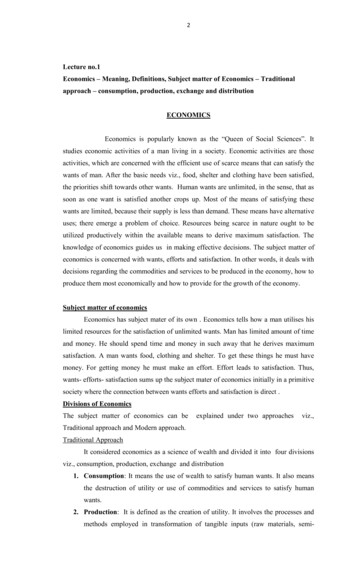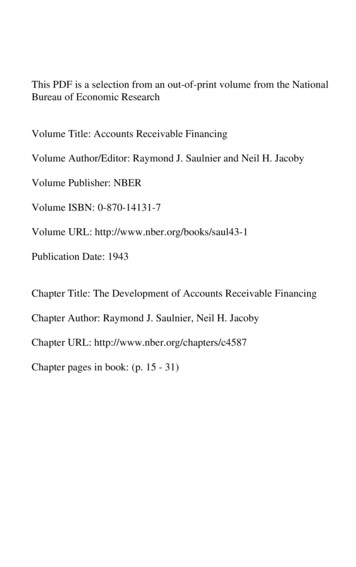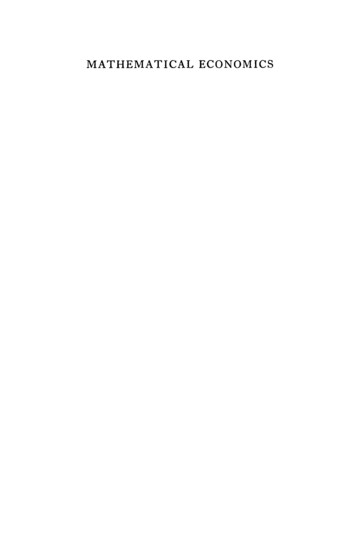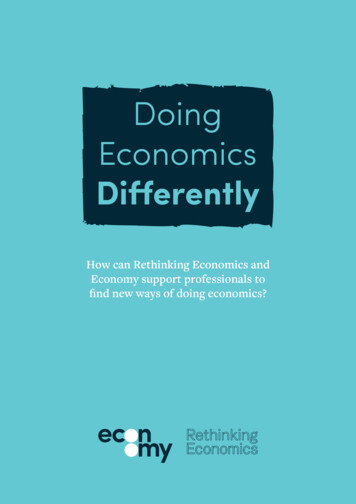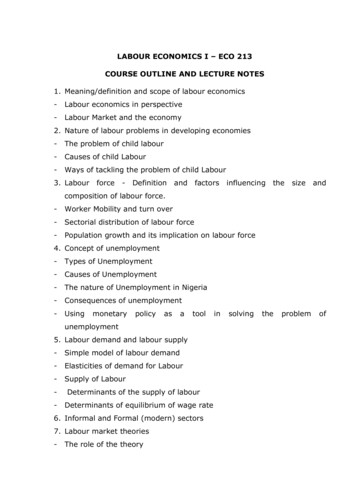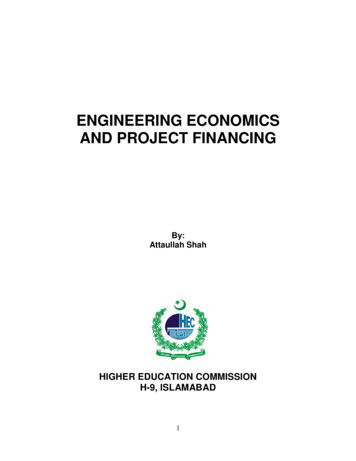
Transcription
ENGINEERING ECONOMICSAND PROJECT FINANCINGBy:Attaullah ShahHIGHER EDUCATION COMMISSIONH-9, ISLAMABAD1
ISBN978-969-417-201-92
DEDICATIONThis book is dedicatedto my parents particularly my fatherHaji Amanullah Khan,MA (Persian), LLB, BA (Hons.),who has been the source of inspiration andguidance for me through my life.To my wife and childrenwho always supported me in my personal endeavorsTo my studentswho always provided me opportunities to learn with them.3
ACKNOWLEDGMENTThe author is indebted to theHigher Education Commission (HEC),staff of the Central Library HEC,andthe learned reviewers of the bookfor their kind support and guidancein making this work possible.4
PREFACEThe course of Engineering Economics is a basic Non Engineering part of the Curriculumfor all Engineering Programs in Pakistan. The course covers various terms relating tobasic knowledge regarding Economics, Project appraisals, project management, role ofbanks and financial institutions and optimization theory in the constrained environments.The author having diversified knowledge in the areas of Civil Engineering, Economicsand Project Management has been teaching the courses for about a decade to differentdisciplines of Engineering. The existing recommended books of Engineering Economicand Project Finance are mainly based on the case studies from advanced nations. Theproposed course of Engineering Economics for Engineers approved by HigherEducation Commission and Pakistan Engineering Council has been based to developthis with major focus on the global trends and local issues in the area.The objectives of the course of Engineering Economics as per the curriculum ofEngineering Program 2012, are as follows- To introduce the fundamentals of engineering economics.- To enable students to perform economic analysis of different projectsAt the same time, the project analysis and project financing has also been included inthe cited curriculum, hence the book covers the major concepts of the EngineeringEconomics and Project Financing. This book has been written with the followingobjectives in mind:- Provide a comprehensive book for Engineering students, to enable them tounderstand, the basic concepts of Engineering Economics, Project Management,Project financing, Project monitoring and evaluation, capital budgeting, decisionmaking process etc.- To enable the students to understand various project approval bodies, theirconstitution and financial limits in Pakistan- To familiarize the students with the Engineering problems relating to economicdecisions during selection and evaluation of the projects.- To understand various project preparation and executing, monitoring and controllingdocuments used in Pakistan including, PC-I, PC-II, PC-III and PC-IV etc.- To enable the Engineering students to understand various capital markets, capitalgeneration process and role of Central Bank etc.It is expected that the book will provide a holistic approach for a highly diversified subjectarea of Engineering Economics and Project Financing to the Engineering Students, withspecial reference to Pakistan. The case studies used by the author will also help thestudents to develop better understanding about the real life problems in the subjectareas after their graduation. The author would always encourage critical review of thebook by experts and students for its improvement.5
I pray that the book provides better knowledge, for the students of Engineering tounderstand the basic concepts of Engineering Economics and project financing andapply these to the real life at later stage- Ameen.TABLE OF CONTENTSChapter No1.101020304051.2DescriptionEngineering Economics and its role in Engineering professionsBasic Concepts of Economics1.1.1 The Subject Matter of Economics1.1.2 Micro Economics vs. Macro Economics1.1.3 Concept of Value in Economics1.1.4 Price Demand and Supply1.1.5 Factors of Production and Law of Diminishing Returns1.1.6 Concepts of Markets in EconomicsRole of Engineering Economics1.2.1 Definition of Engineering Economics and its Subject Matter1.2.2 Objectives of Engineering Economics1.2.3 Typical Problems faced in the Engineering Economics field.Some Facts about the Economic Survey 2016-17Pages1222368999Exercise 1Fundamentals of Project Management2.1Project and Project Management2.2Project Life Cycle2.3Project Management Professions2.4PMI approach of Project Management (Processes and KnowledgeAreas)Box 2.1 Alternate Workplaces with the Emerging TechnologiesExercise 2Time Value of Money3.1 Concept of Time Value of Money (TVM)3.2 Future Value of Present Investment ( Compounding Factor)3.3 Equal Payment Series Annuities3.4 Equal Payment Series for Recovery of Capital or Sinking Fund3.5Present Value of Equal Payments made in Future3.6 Importance of TVM in Engineering Decision Making ProcessCase Study House Purchase Plan at the Retirement AgeExercise 3Project Life Cycle and Project Selection methods4.1 Project Life Cycle Phases4.2 Project selection Methods4.3 Project Life Cycle CostingExercise 411Depreciation of Durable 1Rationale for Depreciation of Durable Assets455.2Depreciation Method and Factors Affecting the Selection ofDepreciation Methods466
5.3Methods of Depreciation465.4Depreciation Based on Service Output51Exercise 553Chapter No06Capital Financing and Capital Budgeting in Public Sector6.16.26.36.46.56.6Capital Budgeting ProcessAssessment of Public Sector ProjectsCase Study of Water Resource ProjectProject Preparation in Public SectorIdentification of Project Costs and Benefits in Public Sector projectsCase Study Financial Analysis of the Industrial Project ShoeManufacturing Unit6.7Guidelines for quantification of Costs and Benefits of the public SectorprojectsExample of Public Project of Highways-ExpresswayPublic Private Partnership ProjectsResult Based Monitoring in Public Sector ProjectsExercise 66.86.96.1007Forms of Business and Banking Services7.17.27.37.47.57.67.708Various forms of businessTypes of CompaniesFranchisingTypes of BanksRole of Central banksDevelopmental Financial Institutes (DFIs)International Developmental Financial Institutions ( IDFIs)Exercise 7Project Monitoring and roject Monitoring and Evaluation CycleProject ReportsProject Progress Reports in Public SectorMonitoring and Progress Review MeetingsProject ControllingTypes of Control SystemsExercise 8Project Approval Bodies and Role of Planning Commission of Pakistan9.1PageWorking and Functioning of Planning Commission, Ministry ofPlanning Development and Reforms.Project Development and Reporting FormatsPublic Sector Development Strategy and Public Sector DevelopmentProgram (PSDP)National Project Approving ForumsRevision of Developmental projectsCase Study- Revised PC-1 of 100 bedded Distract HeadquartersHospital78182838384858687878892939496
AppendicesExercise 9References103104Index106Templates of Projects Documents used by Government ofPakistanAnnex-1 PC-1 FORMAnnex-2 PC-II FORMAnnex-3 PC-III FORMAnnex-4 PC-IV FORMAnnex-5 PC-V FORM8
LIST OF TABLESTable 1.1 Total Product (TP), Average Product (AP) and Marginal Product (MP), for VariousLevels of Labor for Constant Resource of LandTable 1.2 Characteristics of different types of marketsTable 1.3 Comparative Statement of the prices quoted by various firmsTable 2.1 Project Life Cycle of a typical Construction ProjectTable 4.1 Weighted Scores of various projectsTable 4.2 Comparison of Payback period for Project A&B based on discounted and undiscountedcashTable 4.3 Comparison of Life Cycle Costing of various options of generatorsTable 5.1 Depreciation values, book value of the machinery during 10 year of service life usingstraight line methodTable 5.3 Depreciation and Book Value at the end of year using sum of digit method.Table 5.2 Depreciation values, book values of asset using declining balance methodTable 5.3 Depreciation and Book Value at the end of year using sum of digit method.Table 5.4 Depreciation cost and book values of the given example by sinking fund methodTable 6.1 Major attributes of projects in public and private sector projectsTable 6.2 Financial Analysis of the Industrial Project Shoe Manufacturing Unit9
LIST OF FIGURESFig. 1.1 Flow of Goods, Services, Resources and money payments in simple economyFig 1.2 Demand and Supply CurveFig 1.3 Total Production (TP), Average Production (AP) and Marginal Production (MP) curves.Fig 1.4 Price at the equilibrium point of demand and supply curves for a perfect market.Figure 2.1 Risk Matrix for various levels of likelihood and consequencesFig 3.2 Graphical representation Equal Payment SeriesFig 3.3 Graphical of Present Value of Equal Payment SeriesFig 4.1 Graphical representation of Break Even PointFig. 5.2 Projects Life Cycle and various documents used in Public Sector (adopted Manual forDevelopment Projects by Planning Commission of PakistanFig 6.1 Project monitoring process in public sector of Pakistan10
CHAPTER – 1ENGINEERING ECONOMICS AND ITS ROLE IN ENGINEERINGPROFESSION1.1 Basic Concepts of Economics1.1.1 The Subject matter of EconomicsEconomics has emanated, as a separate discipline from the basic dilemma of scarcity.The natural resources at the disposal of the human beings are not only scarce but alsodepleting continuously, whereas the human population is increasing exponentially. Thehuman wants on the other hand are not restricted. Hence there is always a competitionbetween the limited natural resources and unlimited human wants. This fact is sometimesattributed to the creation of “Economics” as a field of study. According to George.N.Mankiw (2004)1 ., it is the study how society manages its scarce resources. Theway how, society chooses to allocate its scarce resources among competing demands toimprove human welfare is also called Economics, sometimes. Economics is also definedas “A science that deals with the allocation, or use, of scarce resources for the purpose offulfilling society’s needs and wants”- Addison-WesleyIn any society, the human wants are satisfied with production and consumption ofproducts and services. Products are tangible, which can be easily visualized, stored,transported and assessed. The consumer products like dairy products, beverages, fooditems etc. are some examples. The services on the other hand are intangible, which canneither be stored nor easily judged. For example teaching, consultancy services, healthservices, financial services etc.HouseholdsBusinessesConsume final goods andservices produced bybusinesses and ServicesProvideGoods & Servicesto consumersProvideProductive inputs tobusinessesUse resources andservices providedby householdsMoney payments for resources, rents and wages, salaries and profitsEconomic Resources, Land, Labor and CapitalFig. 1.1 Flow of Goods, Services, Resources and money payments in simple economy1Principles of Economics, N. Gregory Mankiw, Economica, September 2004.11
In simple model, the society is hypothetically divided into two groups i.e. Businesses andHouseholds. The businesses produce goods and service for the consumers and acquireresources as well as inputs provided by the households. Whereas, households consume goodsand services and provide inputs to them. This simple model is given in Fig. 1.1. The inputsprovided by the consumers are in the form of capital, labor, land and entrepreneurships etc.Some of the Economics problems faced by this model areThe nature of goods and services to be provided by the businesses.The ways and means to produce goods and services.How the good and services need to be distributed amongst the consumers.Economics as a discipline is attempting to search answers to such questions.1.1.2Macro Economics and Micro EconomicsMacroeconomicsMacroeconomics is branch of economics that studies the behavior of the wholeeconomy at the national or international level. The economic variables such asemployment, income, general price levels at the national level are aggregated. Themacroeconomics addresses the issues of inflation, deflation, unemployment and povertyas a whole at the national lelvel. Thus the focus of macroeconomics is always the wholesystem.MicroeconomicsMicroeconomics on the other hand deals with the behavior of individual firm and family.Microeconomics is mostly applied to operational level in the organizations. It covers theimportant areas like demand, supply pricing of product, consumption and economicwelfare.There is an apparent relationship between the two, as the aggregate production and consumptionof goods and services would depend upon the individual choices made by the households andfirms.1.1.3 Concept of Value in EconomicsThe concept of economic value is very important while making economic decisions. It issomeone is willing to pay for a good or service. It measures the preference and priority ofthe consumer. The value has two aspects, one is “value in use” and other is “value inexchange”. The concept of Value Analysis is more commonly used to deliver the requiredproducts and services to deliver the desired functions at the minimum costs. ValueAnalysis is a systematic design review concentrating on the reduction of the directmanufacturing cost of the product.1.1.4 Price Demand and, SupplyThe demand for various goods and services is affected by the price. According to Law ofdemand, “The demand of a product decreases with the increase of its price, provided thatother things remain the same”. Demand of goods and services is also affected by incomeof the people, prices of the substitute and complimentary goods, and tastes and habits ofthe people.On the other hand, according to Law of Supply, “The supply of goods/products increaseswith the increase of prices and vice versa”. The supply of goods is also affected by thefollowing factorsCost of inputsWhen the cost of inputs is increased, the production cost also increases and as aresult the supply of related goods decreases. With the increase in the prices offertilizers, seeds and pesticides, the supply of wheat also reduces.12
-TechnologyWith the advanced technologies, the cost of production decreases, and thesupply of goods increases. For example, with the improvement ofmicroprocessors, the cost of production of Laptop computer has decreased andas a result, its supply has increased.-WeatherThe demand of warm and woolen clothes increases in severe winter.-Prices of related goodsIf prices of related goods decrease, the prices of main goods are also affected.For example when the prices of LCD decreases, the prices of TV also decrease.Figure 1.2 Demand and Supply Curve1.1.5 Elasticity of demand and supplyThe responsiveness of demand or supply due to change in prices, income, prices of othercommodities, is called “Elasticity of Demand or Supply”1.1.5.1 Price Elasticity of demandThe degree of response of demand to the change in the prices is called “Elasticity ofdemand”. Mathematically Price Elasticity of demand is given as% 𝐶ℎ𝑎𝑛𝑔𝑒 𝑖𝑛 𝑞𝑢𝑎𝑛𝑡𝑖𝑡𝑦 𝑑𝑒𝑚𝑎𝑛𝑑𝑒𝑑𝑃𝑒𝑑 % 𝑐ℎ𝑎𝑛𝑔𝑒 𝑖𝑛 𝑝𝑟𝑖𝑐𝑒If Ped 1 The goods are elasticIf Ped 1 The goods are unitary elasticIf Ped 1 The goods are inelastic1.1.5.2 Income Elasticity of DemandIt represents the degree of change in demand with the change in income of an individual.For normal goods, the demand increases with the increase in income but for inferiorgoods, demand falls as income rises and vice versa. Income elasticity of demand is givenas% 𝐶ℎ𝑎𝑛𝑔𝑒 𝑖𝑛 𝑞𝑢𝑎𝑛𝑡𝑖𝑡𝑦 𝑑𝑒𝑚𝑎𝑛𝑑𝑒𝑑𝑌𝑒𝑑 % 𝑐ℎ𝑎𝑛𝑔𝑒 𝑖𝑛 𝑖𝑛𝑐𝑜𝑚𝑒13
Where 𝑌𝑒𝑑rrepresents, income elasticity of demand1.1.5.3 Cross Elasticity of DemandIt is the responsiveness of demand of one good due to change in prices of other goods.These goods may be complementary like tea and sugar or substitute such as ghee andoil. In case of supplementary goods, the increase in price of one good will also reduce thedemand of other goods and vice versa. For example when the prices of fuel increases,the demand for large fuel inefficient cars decreases. . The cross elasticity is negative orinverse. In case of substitute goods like oil and ghee, the increase in price of ghee willlead to increase in demand of oils and vice versa. The cross elasticity Xed in positive ordirect.% 𝐶ℎ𝑎𝑛𝑔𝑒 𝑖𝑛 𝑞𝑢𝑎𝑛𝑡𝑖𝑡𝑦 𝑑𝑒𝑚𝑎𝑛𝑑𝑒𝑑 𝑜𝑓 𝑝𝑟𝑜𝑑𝑢𝑐𝑡 𝑋𝑋𝑒𝑑 % 𝑐ℎ𝑎𝑛𝑔𝑒 𝑖𝑛 𝑃𝑟𝑖𝑐𝑒 𝑜𝑓 𝑝𝑟𝑜𝑑𝑢𝑐𝑡 𝑌1.1.5.4 Elasticity of SupplyThe degree responsiveness of the supply of a goods is to change in prices, is called“Elasticity of Supply”. When the supply of goods can’t react quickly to the changes inprices, the price elasticity of demand is called “Inelastic”. In case the supply react quicklyto changes in prices, these are inelastic. The price elasticity of supply Pes is given as% 𝐶ℎ𝑎𝑛𝑔𝑒 𝑖𝑛 𝑞𝑢𝑎𝑛𝑡𝑖𝑡𝑦 𝑠𝑢𝑝𝑝𝑙𝑖𝑒𝑑𝑃𝑒𝑠 % 𝑐ℎ𝑎𝑛𝑔𝑒 𝑖𝑛 𝑃𝑟𝑖𝑐𝑒 𝑜𝑓 𝑝𝑟𝑜𝑑𝑢𝑐𝑡 𝑌The elasticity of demand or supply depends on the following major factorsDuration of assessment when the period of assessment is more, the elasticity is likely tobe more.Availability of number of substitute goods greater the number of substitute goods, morewill be the elasticity.Income use for a particular good: More the income used for a particular product, morewill be the elasticity.The nature of product: If the product is necessity, despite of increase of price, thedemand may not reduce due to its essential nature.1.1.6 Factor of Production and Law of Diminishing ReturnsIn economics, the factor of production is the inputs which are used to make economic profit,which include Land, Labor, Capital and Entrepreneurship. The land mainly refers to all rawmaterial which we derive from land. Labor refer all types of human resources used for physicaland intellectual works. Capital is used for all tools, machinery, buildings, equipment etc. used forproduction of goods and services. Entrepreneur is a person which provides innovative ideas andcreativity to make used of other factors effectively and efficiently.The Law of Diminishing ReturnsIf one factor of production such as labor, is increased, while other factors of production remainunchanged, the production level will initially increase, but after some period it will eventuallydiminish. The marginal returns of a factor, is change in production with unit change in the input ofthe factor. The marginal returns would thus decrease with the increase in the increase of singlefactor of production, while other factors are kept constant (Ceteris Paribus). The Law ofDiminishing Retunes is the fundamental principle for the Production Theory.Richard A. Bilas describes the law of diminishing returns in the following words "If the input of oneresource to other resources are held constant, total product (output) will increase but beyondsome point, the resulting output increases will become smaller and smaller". The net increase inthe production with the unit increase of a particular input, is also called marginal production. Thismarginal production would decrease gradually and at a point, it will become zero and beyond14
that, the marginal production will be negative. Certainly production at beyond zero marginalproduction is not advisable.The Total production curve and marginal production curve can be illustrated with the help offollowing Table 1.1. The curves for TP, AP and MP are shown in Fig 1.Table 1.1 Total Product (TP), Average Product (AP) and Marginal Product (MP), for VariousLevels of Labor for Constant Resource of Land.Fixed ResourceLand( Acres)15 Acres15 Acres15 Acres15 Acres15 Acres15 Acres15 Acres15 344.674.754.604.3335-654378282943.6321( Labor)30Total Product (TP), Average Product (AP) and Marginal Product (MP)6TPUnits of Product525204AP153APMP102MP150012345TP6Units of LaborFigure 1.3: Total Production (TP), Average Production (AP) and Marginal Production (MP)curves1.1.5 Theory of Economic PricingPrice is the quantity of payment or compensation given by one party to the other party inreturn of goods or services. Historically, the price was measured in terms of products andservice, under Barter Exchange. In modern economics, this exchange is commonlymeasured in the form of some currency for specified quantity of product such as Rupeesper Kg of rice.15
In perfect competitive market where all products are like and entry and exit to the marketis free, price is determined at the equilibrium point of Demand and Supply, as shown inFig 1.4.Fig 1.4 Price at the equilibrium point of demand and supply curves for a perfectmarketPricing mechanism refers to the system, where free market forces of demand and supply ofgoods and services establish their prices. However in some cases, Government interventions arerequired to regulate the prices.1.1.6 Concept of Markets in EconomicsIn Economics, the term market is a place having its specified boundary, wherecommodities including goods and services are traded and the customers and sellers areavailable to buy and sell them. The prices of the commodities are influenced by theirsupply and demand in the market. Market can be divided into local, regional, national andinternational markets, based on their territorial extent. The term market competition refersto the battle for vying the customers, where the firms exert to attract customers of themarket at the cost of other firms operating in a market. Based on market structure, thedegree of competition may vary from market to market. This competition may come fromthe same type of commodities and firms or other substitute commodities. For examplecompetition to Bus service Company in a city may come from the new Bus serviceCompany in the city, or the operation of new taxi services like Careem and Uber etc.The degree of such competition may depend on a number of factors such asi.Number of firms operating in the marketWhen the telecom services and Cellular phones were introduced in Pakistan, onlyone firm “PakTel” was the sole operator in the market. However with more moderntechnologies, a number of new Cellular phone operators like Zong, Telenor, Warid,U-Phone etc. also got the licenses for operation in Pakistan and as a result, themobile/Cellular phone market has become highly competitive.ii. Availability of substitute productsProducts have substitutes and in case of shortage of supply of such products orincrease in demand, people opt for substitute products. For example, people wouldprefer to buy cheap forms of sweats, when the prices of sugar would increase andvice versa. The availability of substitute products, would also affect the competition inthe market. On the other hand, for services like electricity, which is solely controlled16
by Government through WAPDA, there is no reliable substitute product and themarket is monopolized by the sole service provideriii. Market Control or barriersMany markets are difficult to enter due to geographic or regulatory barriers. The easeof entry to the market also generates high degree of competition. The propertymarket in Pakistan is relatively easy to entre as it does not require any license,qualification or huge investment.Customers’ knowledgeIt is generally believed that the customers have equal knowledge in a hypothetical market but inreality it seldom happens, as it would depend on the age, knowledge, education, income etc. ofthe customer and would vary from person to person, region to region. However with the advent ofInformation and Communication Technologies (ICTs), the access of the customers to correct andtimely information about the products has increased, which can make the markets morecompetitive.1.1.6.2 Market Structure and its determinantsThe market structure determines the behavior of the firms and customers, based on the followingmajor determinantsi.Pricing strategyThe pricing strategy of the market is the basic determinant of the market structure.This strategy is determined by the firms in view of the degree of competition in themarket. There are two pricing strategies for a new product or firm to enter in themarket, namely market penetration strategy and market skimming strategy. Inpenetration strategy, the firm hits the lowest possible price to grab major marketshare as we see in case of English Toothpaste, Dentonic toothpaste, Tapal tea etc. In skimming strategy, the firm targets top market share with high quality andinnovative products. For instance “Colgate Sensitive Teeth”, which is 10-15 timescostlier than the English toothpaste, is targeting the top 10% share of consumers.ii.Supply of goods and servicesIn case of more supply of the products in the markets than the demand, surpluswould be created, and this would affect the pricing and other attributes of the market,till market equilibrium is reached.iii.Barriers to entry to the marketIn highly regulated market, the entry of new firms is generally restricted or limited,which affects the market competition and structure.iv.Efficiency of the marketIn more efficient market like services markets, the returns are normally higher andthe competitive strength and pricing etc. is accordingly affected.v.Competition in the marketThe nature and degree of the competition in the market, determines the structure ofthe market, these various types of the markets are discussed in the next section.1.7 Types of Market StructuresMarkets may be having perfect completion on one hand and monopoly on the other. The varioustypes of the market structures are discussed as follows-Perfect CompetitionThis is more or less a hypothetical market, where firms are free to enter the market, selland buy their products which are assumed to be homogenous, their number is large,17
Perfect competition rarely exits, yet some of the market like Stock Exchanges, Financial,bond markets and vegetable & fruit marketsare closer to perfect markets, whereextensive competition, availability of large number of products and buyers & sellers makeit more like perfect competition.-Imperfect or monopolistic competitionIt is the other extreme of the market, where relatively lesser number of firms havemonopoly over the products and the products are differentiated. The examples ofimperfect competition are restaurant chains, Engineering goods, professional servicesetc.-OligopolyCompetition amongst few sellers, such kinds of markets is dominated by few firms with veryrestricted entry. The products are differentiated with apparently less price competition. Theprofit margins are normally very high and there is high tendency of collusion to establishhigh prices. Some of the examples are Supermarkets, Banking, Oil Companies andBroadcasting etc.-DuopolyIn Duopoly, two firms are operating the market. Such markets are restricted due to highbarrier to entry. The two firms closely watch the actions and strategies of each other andrespond immediately to it. The example of Airline Services, Electricity services, Gas servicesetc. he salient aspects various types of market structures are given in Table 1.2Table 1.2 Characteristics of Different Types of MarketsCharacteristics of MarketNature and Type of onOligopolyNo of Firms/CompetitorsManyFew to manyFewEasy of entrySimilarity of goods andServicesControl over price by the firmEasySimilarSlightly ilarSomewhatExamplesRetail o but nodirect pricecompetitionGovt. regulatedNo directcompetitionConsiderable inpure monopolyUtilities marketssuch as water ,natural gas,telecommunications servicesetc.1.2 Role Engineering Economics1.2.1 Definition and subject matter of Engineering EconomicsEngineering decisions cannot be significant unless these are supported by strong economicvalue. Exploring cost effective and efficient solutions to the Engineering problems has been thecorner stone of all Engineering related recommendations. Any Engineering project has to betechnically sound, socially acceptable, environmentally sustainable and economically feasible.Hence Engineering decisions are always based on sound knowledge of economics.Engineering Economics deals with the concepts and techniques of analysis useful in evaluatingthe worth of systems, products, and services in relation to their costs. The major objective of theEngineering Economics is to maximize the value of investment to improve the system, processes,18
products and services for the welfare of the society. Engineering decisions are critical to thesocial, technological and physical welfare of the human beings. These decisions will be aimed atmaximize benefits and minimize costs to the society.1.2.2 Importance of Economics for Engineers and why “Engineering Economics”Albert Einstein differentiated between Engineers and Scientists as, “Scientists deals with theproblems of existing things, whereas Engineers create new things”. Creativity and innovations isthe major asset of the Engineers.Dean Gordon Brown said ““Engineering is, not merely knowing and being knowledgeable, like awalking encyclopedia; engineering is not merely analysis; engineering is not merely thepossession of the capacity to get elegant solutions to non-existent engineering problems;engineering is practicing the art of the organized forcing of technological change. Engineersoperate at the interface between science and society”.”In practical life Engineers are faced with multitude of situations, where economics analysisbecomes the major driver for Engineering decision making. Some of such questions andscenarios are discussed as follows:-Project Investment related decisionsThe nature of project design, the level of investments in the projects and mix of projects(Project portfolio) all involve Engineering analysis.-The Analysis of various alternative solutionsEngineers always provide multiple solutions to the problems faced by organization andsociety. The selection of best suitable solution for a particular situation will involve econ
Basic Concepts of Economics 01 1.1 Engineering Economics and its role in Engineering professions 1.1.1 The Subject Matter of Economics 1 1.1.2 Micro Economics vs. Macro Economics 2 1.1.3 Concept of Value in Economics 2 1.1.4 Price Demand and Supply 2 1.1.5 Factors of Production and Law of Diminishing Returns 3




